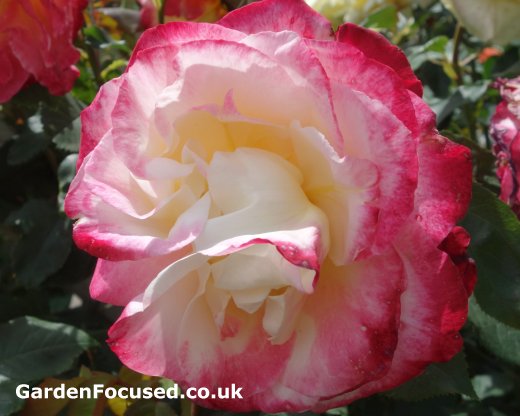BACKGROUND
The Double Delight rose was bred
by Swim and Ellis in 1977. The source of the name is not 100% clear. Some believe the “double” part of the name refers to beautiful blooms combined with a delicious, strong scent. Other believe it refers to the two tone (dark pink and white / ivory) colour of the flowers.
It has won many awards, some of which are shown below:
Baden-Baden Rose Trials Gold Medal 1976.
Rome Rose Trials Gold Medal 1976.
Geneva Rose Trials Fragrance Award 1976.
Rose Hall of Fame 1985.
APPEARANCE
Double Delight grows to between 90cm to 150cm (3ft to 5ft) tall and a similar width. Foliage is a matte green colour with larger then average leaves and the stems have an above average number of thorns.
The flowers are the true beauty of this variety. As the flowers form andbegin to open out they are white / ivory. As the flowers fully open, the outerpetals turn a deep pink and the inner petals are tinged pink at the edges. Thereis a strong spicy / sweet scent. Larger than normal, each flower is about 10cm(4in) wide.
Light levels and the amount of exposure to sun will dictate the colour of the flowers. The more sun, the more pink will be the flowers. As an aside, if this variety is grown in a greenhouse the red colour will be almost missing – greenhouses filter out ultra-violet light which is what causes the red colouration.
Flowers are carried on longish single stems which makes them ideal for cutting and displaying indoors. In an average year there will be two main flushes of flowers with a few flowers in between.
They are suited to growing in containers, flower beds and as a low hedge.
PESTS AND DISEASES
Double Delight was introduced in 1977 and is not as disease resistant as many more recent varieties. The prime disease problem with this rose variety is powdery mildew. Neem oil and other treatments for powdery mildew should be considered when growing this rose variety
It is also not immune to black spot but this is controllable if you follow our instructions on controlling black spot which can be found here.
HOW TO PRUNE A DOUBLE DELIGHT ROSE
Prune a Double Delight rose as follows:
- Remove all stems which show any signs of disease or damage. Cut them back to ground level or back to a main stem.
- Remaining stems should then be pruned back to 15cm / 6 in from ground level. This will allow you to get a good view of the structure of the rose bush.
- Now prune the rose bush so that it has four or five stems arranged equally apart roughly in a circle from the centre of the plant. These stems should ideally be growing out from the centre of the bush.
- Compromise may be required but the idea is to keep the centre of the rose bush open and have the branches growing outwards. This is to allow air circulation to the centre of the plant and avoid infections.
- When selecting stems, make sure that you remove stems which are touching or nearly touching another stem. Where stems are touching, they will rub off the outer bark and allow infections to enter.
- Green stems are healthier and younger than browner stems so remove the browner stems and leave the green stems which are more vigorous.
- When selecting the stems to remain, don’t leave spindly stems. Your are looking to have four or five stems which are at least the thickness of a pencil, hopefully thicker.
SUMMARY OF ROSE DOUBLE DELIGHT
HEIGHT: 90cm to 150cm (3ft to 5ft)
SPREAD: 75cm to 150cm (30in to 5ft)
ROSE TYPE: Hybrid Tea, repeat flowering over the summer andearly autumn
FLOWER COLOUR: Dark pink and white
FRAGRANCE: Strong spicy and sweet
LEAVES: Matte mid green
THORNS: Slightly more than average
UK HARDINESS: -20C
USDA ZONES: 8b to 4b
DISEASE RESISTANCE: Medium, suffers from mildew andsometimes blackspot.
GROWING CONDITIONS: Full or partial sunlight (four hours ormore sun)
SOIL CONDITIONS: Almost all soil conditions except dry or water-logged soils
CONTAINER GROWING: Can be grown in a large container
BREEDER: Swim and Ellis in 1977
AWARDS: Many awards (see above).
MORE IN DEPTH ROSE REVIEWS
Click here for more in depth reviews of our recommended rose varieties.

Planting a Rose Bush
Caring for Rose Bushes
Prunining Rose Bushes
Propagating Rose Bushes from Hardwood Cuttings
Pests and Diseases of Rose Bushes
Comparison of online rose suppliers
DOUBLE DELIGHT ROSE
Double Delight was first introduced in 1977 and was an immediate success. One of the most beautiful rose flowers of all time if carefully looked after.Because it was bred several decades ago it is however more susceptible todiseases compared to more recent cultivars.
With the correct care this is a spectacular rose variety which is suitable for growing in flower beds or a largish container.